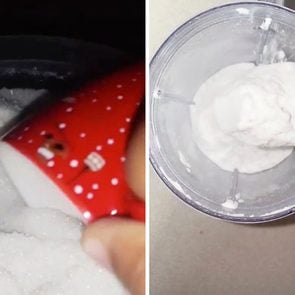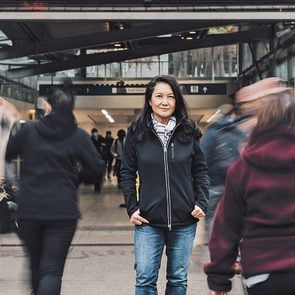Using aluminum foil to line a baking dish, pan or tray is a handy trick that ensures an easy cleanup. The catch? Well, sometimes foil can be hard to mold and shape, leaving recipes that take hours to assemble looking a little off. Foil also tears easily, which contradicts using it in the first place, leaving you with a mess to clean on top of the dishes already in the sink.
When you’re up to your elbows in homemade fudge, the last thing you want to worry about is perfectly stuffing aluminum foil into a baking dish.
Here’s a handy trick to make all of your aluminum foil endeavors quick, simple and no-fuss.
How to Line a Pan with Aluminum Foil
This viral TikTok by @saucedupfoods starts off by showing how a lot of us use foil, struggling to mold it to the bottom and sides of a baking pan. Then, the hack! You flip over the loaf pan so it’s upside down. Then, shape the foil tightly over the outside of the dish.
After removing the foil rectangle—which is now in a stiff shape—and turning the pan upright, the foil fits perfectly into the baking dish. No tears or scalloped sides in sight.
@saucedupfoodsNever use foil the same way with this hack #hacks #hacksandtips #YasClean #learnontiktok #foil #fyp♬ Banana (feat. Shaggy) [DJ FLe – Minisiren Remix] – Conkarah
Pretty simple, right? We think so, too.
Can I Line Any Baking Pan with Foil?
Yes! Now that you know how to effortlessly line your baking dish in seconds, it’s time to take on some new recipes. In the TikTok video, the creator uses what looks like a generic 9-by-5-inch loaf pan, but this hack should work on casserole dishes, muffin tins, cake pans and more. You can test this method with homemade fudge, sheet pan dinners and even custom-shaped cakes for any occasion. Now it’s your turn to use this foolproof trick!
Next, check out how to make store-bought frosting taste homemade with this simple trick.
Reader’s Digest Canada: What kinds of behaviours become safe after you get the COVID-19 vaccine?
Dr. Isaac Bogoch: We’re entering a period of time in Canada where some of us have not yet been vaccinated. Some of us will have one dose of a two-dose vaccine series and some of us will have completed a full two-dose vaccine series—and the ratios between those three categories is going to change with time as the vaccine program rolls out.
We have not yet heard guidance from senior public health leadership in Canada as to what acceptable behavior will be while we have people with no vaccinations or partial vaccinations. However, the United States’ Centers for Disease Control and Prevention has come out with some very clear guidelines on what fully-vaccinated people can do. That includes, for example, that you can get together with other fully-vaccinated people for a small gathering in someone’s house, without masks and without physical distancing.
That’s great. So the vaccines are working, then?
We know that the vaccines are really, really good. Regardless of which vaccine we’re talking about, it will significantly reduce the chance that someone is going to get COVID-19. And if someone is unlucky enough to get COVID-19 after vaccination, their probability of getting sick or requiring hospitalization is greatly reduced.
If someone is partially or fully vaccinated, can they still carry the virus and transmit it to other people?
We know from clinical trials and real-world data that’s been published that people who are partially vaccinated or fully vaccinated can still get the infection and can still transmit it to others. However, it appears that the risk of getting the infection is really, really small and the risk of transmitting to others is also greatly reduced following vaccination. It’s not zero per cent, but it’s significantly lower.
Given that, could a fully vaccinated grandparent visit their unvaccinated child and grandchild?
If the grandparents are fully vaccinated, and their children and grandchildren are a low risk for COVID-19, the grandparents can certainly be close with them and hug them. The risk is that the grandparent will be infected, but since the grandparent is vaccinated, it would be extremely unusual for them to get infected. As for the others, it’s possible they could get sick, but it’d be very rare.
Okay, so how do you know if the rest of the family is low risk?
They’re low risk if they haven’t had significant exposures to COVID-19 and are completely without symptoms. So for the grandkid, it would probably depend on the school they’re in and where in Canada they live. Ultimately, though, it’s going to be hard to clearly define what low risk is. There’s not a cookie cutter answer here. We don’t want anyone to get this infection, but the main point is to protect older populations or people who are vulnerable to having severe outcomes.
For the two-dose vaccines, what’s the difference between one shot and two in terms of risk of infection and transmission?
We know that two weeks after the first shot, people are provided with pretty significant protection against the virus. It’s not as good as having two shots but one shot still provides significant protection and we’ve even seen that in real-world data from the United Kingdom. Having said that, these are still two-shot vaccines and people won’t realize the full potential of protection until they’ve received their second dose. Personally, I think it’s reasonable for most people to wait until they’ve received the full course of the COVID-19 vaccine before they start to relax some of the restrictions in small group settings, and that’s what the CDC suggests.
Would you say waiting for the full course is more important for certain people?
It’s much more important for people on the older end of the spectrum and people with any degree of compromise to their immune system, whether it’s through a cancer diagnosis or medications they’re on. Those people are much less likely to be afforded the same degree of protection against COVID-19 following one dose of a vaccine compared to otherwise healthy, younger individuals with no compromise to their immune system.
If someone is fully vaccinated, do we know yet how long the vaccine is effective?
It’s not entirely clear yet what the duration of protection is for people who are fully vaccinated. It’s probably going to be different in different people—longer in younger individuals or individuals who don’t have any immune issues and shorter for older people or people who are immunocompromised. But we don’t yet know and that’s being studied.
Okay, but are we talking about weeks, or months?
I was thinking in terms of a year or more. Is COVID-19 something that we’re going to need an annual vaccine for? Hopefully not, but maybe. It might be every year, or every two or three years. Regardless, this is only the first version one of our COVID-19 vaccines and pharmaceutical companies are already creating vaccines that account for the circulating variants of concern right now. So no matter which vaccine people get in Canada in the spring or summer, we’re all probably going to need a booster shot at some point in the very tail end of 2021 or at some point in early 2022 that accounts for the variants.
How effective against the variants are the vaccines we’re getting now?
There are several different variants of concern and several different vaccines. In general, all the available vaccines work against the variant of concern that originated in the United Kingdom. And it appears that most of the vaccines will provide some degree of protection against the variants of concern that originated in South Africa and Brazil, but they don’t afford the same degree of protection. It’s not nothing but it’s lower in general. This is an active area of research and the pace of knowledge acquisition is moving very quickly.
Do you know if there’s going to be some kind of documentation or “vaccine passport” you get when you’re fully vaccinated?
I think many countries are figuring this out. Right now in Canada, you get a little slip of paper. In Ontario, there’s also an electronic record for everyone who is vaccinated that includes the time, date and type of vaccine. I think this is true for other provinces as well.
And will you need this proof to travel?
Already, you can’t travel to over 60 countries on the planet without proof of vaccination for yellow fever. That exists, and has been around for decades. If you show up at those countries, when you land and you get off the plane, they check for proof of vaccination. If you don’t have proof of vaccination for yellow fever, one of two things happens—you turn around and get on the first plane out of there at your own expense or you go to the little infirmary in the airport and they’ll vaccinate you for yellow fever and then you can come in.
So I would not be surprised if we start to see more and more countries wanting to see evidence of COVID-19 vaccination prior to entry. It doesn’t mean it’s right, but it’s likely going to happen. There’s obviously tremendous equity and ethical issues. Can you force someone to have a vaccine to enter your country? What if people are coming from low-income countries and don’t have access to vaccination there? Can you prevent them from travelling? If you’re a country that has access to vaccines, maybe you could provide those vaccines at the border for people that want to enter.
And do you think this proof of vaccination will need to be used for doing things closer to home?
Within a country, you’ll see something like what’s happening in Israel—if you’re vaccinated there, you can enter restaurants and bars and movies and other places where people congregate together. Whether we like it or not, I think that’s going to be part of our future.
Next, find out what’s meant by “herd immunity”—and when it’s expected to happen.
The Guest Arrives
By the spring of 2017, my husband, Spencer, and I had been trying to conceive for over three years. Diagnosed with a condition infuriatingly called “unexplained infertility,” we had hovered hopefully over dozens of pregnancy tests only to see them come back negative. I was near-constantly consumed by the painful disappointment of not having a baby—that is, until Easter weekend of 2017, when a rabbit showed up on our front lawn.
My neighbour spotted the impossibly fluffy creature first, finding him nestled in the grass while she was walking down our street in Toronto’s west end. She scooped the bunny up, wrapped him in a worn bath towel and, along with a comically large chunk of carrot, placed him in a clear plastic bin. She then carried him up my steps and knocked on my door.
“Is this your rabbit?” she asked.
I had to laugh. He was not my rabbit. However, covered with pristine white fur freckled with pale grey spots and marred with only a small nick on one of his ears—probably from a prowling outdoor cat—he was very likely someone’s rabbit.
My neighbour was going away that weekend, and since the bunny decided to take up residence on my lawn, I felt a genuine sense of responsibility for him. With three rescued animals—a dog and two cats—already calling my house home, it was predictable I’d volunteer to take care of this particular stranger, at least for a few days.
We Called Him Easter
During that first weekend the bunny stayed with us, we tried our best to spread the word that we’d found him. Given how adorable he was, surely a family was out there missing him, a family who would see our “FOUND RABBIT” tweets or come across the posters we affixed to lampposts throughout the neighbourhood.
In the meantime, we named the rabbit Easter and gave him his own bedroom. We moved our dog’s old crate from the basement into our spare room—the one I’d planned to turn into a nursery—and filled the crate with soft blankets and a specialty hay I found at the local pet store. I sat the bunny on my lap and fed him lettuce, spinach and kale. I peeled bananas and watched him nibble away at them. Sometimes I would let him bounce around on my bed while I read books or watched TV. Other times I would cradle him like a baby and stroke his tiny head while his tiny pink nose twitched.
At the time the bunny showed up, I was in my late 30s and I knew my chances of conceiving were decreasing. I had already seen multiple specialists and had been subject to invasive medical questions, tests and procedures. I also knew that the process, and the despair of not being able to have a baby, was taking its toll on my mental health.
I often tell people that the experience of infertility is like a grief over something you’ve lost but had never known—a grief that won’t end until you finally give up the hope of ever knowing it. It’s a kind of mourning that people simply can’t understand unless they’ve experienced it. And while friends and family did their best to comfort us, as the years passed, it became easier to carry those feelings alone than to continually attempt to explain them.
How many times—and how many months—can you miss a hypothetical child, a child that you cannot have, before that longing destroys you? How long before you have to move on, if you even can?
A New Home
A few weeks after we’d taken Easter in, no one had responded to our postings, but lots of people had come to visit, each wanting an opportunity to hold the rabbit in their arms and scratch him between his ears. Several people even offered to adopt him, but each had to back out at the last moment—a partner with an allergy, an impending trip, a fear of too much responsibility.
I learned a lot about rabbits during the time our visitor stayed with us. I learned that this bunny was indeed domestic—a Rex, to be specific; a plush, velvety breed that originated in France in 1919. I learned that it’s very common for rabbits to be abandoned, especially around Easter, when they’re procured for amusement and then simply “let go.”
And, lastly, I learned that rabbits live in groups, and that the instinctual thumping they do with their back legs is a way to warn the rest of the warren of danger. I discovered this first-hand because, despite how safe and comforting I tried to make this rabbit’s world, how badly I wanted him to stay, the three other pets in my household terrified him.
After delaying his departure as long as we could, we finally contacted a nearby animal rescue about finding Easter a forever home.
A few days later, on a Saturday morning in May, after his month with us, we passed our bunny to a pair of women who would arrange an adoption. We struggled as we said goodbye and scratched between those upright ears a final time.
It’s funny how you develop a quick affection for things that were never really yours, how you fall in love with ideas and lives you may have lived. As much as I wanted to keep the rabbit, as much as it hurt to fold up the crate and sweep the hay from the bedroom, it also felt good to have taken Easter in, to have given him a safe home until a better one came along. If anything, our surprise house guest had given me a break from the thoughts that I couldn’t shake, a reprieve from yearning, a place to put my attention and care.
And within a week of letting him go and saying goodbye, I was pregnant.
Holding Onto Hope
My daughter turned three this year and sleeps in the same room in which the rabbit lived during the spring she was conceived. Sometimes when she wakes up in the middle of the night I lift her from her bed and hold her body tight to mine, still feeling that ache I had for all those years without her. It’s as if the grief I carried with me for so long still lingers, like I am still healing that open wound that left me so vulnerable, still missing her even though she’s right here in my arms.
Though the grief of infertility remains, so does the hope I refused to let go of through all of those disappointing, painful months without her. It turns out that my unending faith did not cause my grief but instead helped me endure it. It’s what kept me looking to the future, believing that things could and would get better—no matter what that future ended up looking like.
I’m not sure I believe in magic, omens or even good-luck charms, but when I hold my daughter close to me in the middle of the night, I think of the rabbit we took in that spring, and I know I still believe in hope.
Next, read about a puppy who helped one family through the pandemic.





